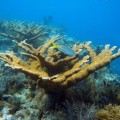A recent experiment by scientists at the Smithsonian Tropical Research Institute in Panama has revealed just how rising atmospheric carbon dioxide will deliver a one-two punch to coral reefs in coming decades, potentially knocking them out by preventing growth in juvenile corals. The combination of rising water temperatures and acidity, the experiment demonstrates, essentially starves juvenile coral larvae, creating an environment where more energy is needed to create their calcium skeletons, but where none is available.
Increased acidity of ocean waters will require more work for coral to manufacture calcium, yet higher water temperatures will prevent the symbotic zooxanthalle which live inside coral cells from producing sugars and oxygen at the increased levels the coral will need to survive. In essence, explains Smithsonian Associate Scientist Aaron O’Dea, “the coral needs more food and oxygen to make their skeleton, but is actually getting less because of higher temperatures. Within 50 years or so oceanic conditions could seriously hinder the growth of new corals.”
Holger Anlauf, PhD student and short-term Smithsonian Fellow, carefully harvested coral larvae, called planulae, from Porites panamensis – a species of reef coral common in the Pacific coast of Panama. He then nurtured the larvae into juvenile corals under four different treatments containing sea water with: 1) normal, present-day levels of temperature and acidity; 2) increased temperature, 3) increased acidity and 4) combined increased temperature and acidity. The temperature and acidity levels chosen for their experiment reflected levels predicted for the mid- to late-21st century, specifically a rise of 1 degree Centigrade in temperature and a .2 -.25 percent increase in acidity.
During 40 days of observation the researchers found that in the tank with the increased temperature only, the juvenile corals did OK, and in fact grew a little faster, Anlauf says, despite a significant loss of zooxanthallae, a well-known phenomenon known as bleaching.
In the tank with the increased acidity only, the juvenile coral did more or less the same as in the control. There was no obvious impact.
In the tank with a combined increase in both temperature and acidity, the researchers found the juvenile coral was able to settle—attaching themselves to a limestone block placed in the tank—but were much more likely to die after settlement. Calcification growth by the coral was around a third slower that in the other three tanks. “This is particularly striking because the rise in temperature and acidity over the control was very minimal,” Anlauf observes.
The regeneration of any reef, and particularly degraded reefs, relies upon new juvenile corals settling and surviving the early stages of their lives. “If they don’t survive, reefs of the future just won’t exist,” O’Dea says. “Coral reefs are a source of food, coastal protection, refuges and cradles for biodiversity.”
A paper on this research, “A corrosive concoction: The combined effects of ocean warming and acidification on the early growth of a stony coral are multiplicative,” was published recently in the Journal of Experimental Marine Biology and Ecology.–John Barrat







